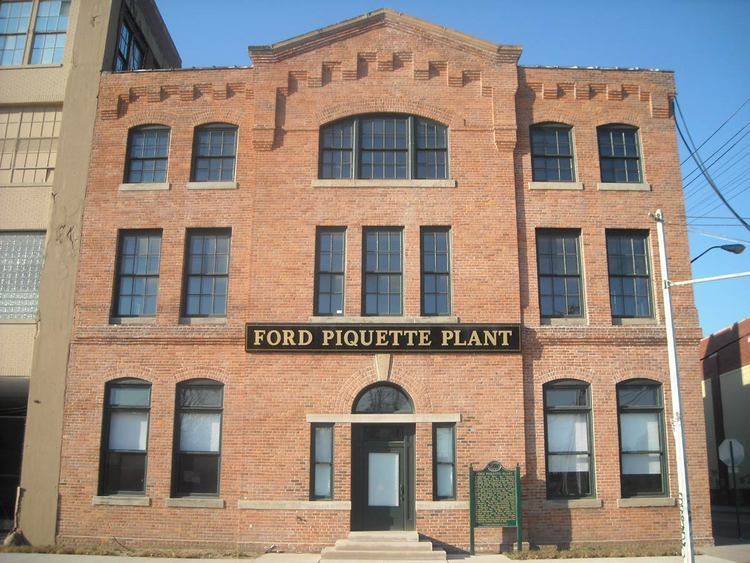Built 1904 NRHP Reference # 02000041 Area 2,024 m² | Opened 1904 Phone +1 313-872-8759 | |
 | ||
Location 461 Piquette AvenueDetroit, Michigan Architect Field, Hinchman & Smith Hours Closed today TuesdayClosedWednesdayClosedThursdayClosedFriday10AM–4PMSaturday10AM–4PMSundayClosedMondayClosed Similar Guardian Building, Detroit Historical Museum, Fisher Building, Ford Motor Company Highland, Fort Shelby Hotel | ||
Ford piquette avenue plant preserving a historical detroit landmark
The Ford Piquette Avenue Plant is a museum and former factory located at 461 Piquette Avenue in Detroit, Michigan, within the Piquette Avenue Industrial Historic District in Milwaukee Junction. It was the second home of Ford Motor Company automobile production and is best known as the birthplace of the Ford Model T. It is the oldest automotive factory building in the world open to the general public. It is approximately 2 miles (3.2 km) west of the original Dodge Brothers factory in neighboring Hamtramck. The building was listed on the National Register of Historic Places in 2002, designated as a Michigan State Historic Site in 2003, and designated as a National Historic Landmark in 2006.
Contents
- Ford piquette avenue plant preserving a historical detroit landmark
- Digging detroit episode 17 birthplace of the model t detroit s ford piquette avenue plant
- Ford period
- After Ford in the 20th century
- Museum transformation
- Critical acclaim
- References
Digging detroit episode 17 birthplace of the model t detroit s ford piquette avenue plant
Ford period
In May 1904, after less than one year in operation, the board of the Ford Motor Company approved construction of a New England mill-style building, on a lot at the corner of Piquette and Beaubien Streets in Detroit, Michigan. The Detroit architectural firm of Smith, Hinchman, and Fields designed the building, which is three stories tall, 56 feet (17 m) wide, and 402 feet (123 m) long. The structure served the Ford Motor Company for only a few years, yet it played a most important role in realizing Henry Ford's dream of an affordable car for the masses.
During the time Ford occupied the Piquette Avenue Plant (1904-1910), the company assembled Ford upscale Models B and K; and Ford entry-level Models C, F, N, R, S, and T. Ford's first model, the original Ford Model A, was built at Ford's previous facility: the Ford Mack Avenue Plant (1903-1904). Henry Ford's previous company, the Henry Ford Company, built a factory on Cass Avenue and Amsterdam Street in 1902. That company was renamed the Cadillac Motor Company after Henry Ford left, and the factory at Clark Street continued in operation until 1987.
During 1907, in a room at the northwest corner of the third floor of the Piquette Avenue Plant, Henry Ford and a small team of dedicated engineers and draftsmen developed the Model T, the car that would change the world. Records at Dearborn show that much of the design and experimental work was done by Joseph Galamb, C. Harold Wills, Harry Love, C.J. Smith, Gus Degener, and Peter E. Martin. Plans for what became the "Car of the Century" were announced in the spring of 1908. In many ways, the Ford Model N was a precursor to the Model T in that it was an affordable, reliable, and innovative automobile. Ford first used vanadium steel extensively in the Model N.
The first production Model T was built at the Piquette Avenue Plant on September 27, 1908. Peter E. Martin was plant superintendent and production manager, while Charles E. Sorensen was Martin's assistant and handled production development. Only 11 cars were built the following month; however, demand quickly grew, and it soon became clear that the facility could no longer keep up with increasing output.
In January 1910, after assembling nearly 12,000 Model Ts at the Piquette Avenue Plant, Henry Ford moved production to his new complex in Highland Park, Michigan. There, he introduced the moving assembly line in 1913-1914 and would eventually produce 15 million Model T Fords.
After Ford in the 20th century
The Piquette Avenue Plant was sold in January 1911 to Studebaker. Studebaker had acquired the E-M-F Company the previous year, which had its own plant located one block west on Piquette Avenue. Studebaker used the former Ford building for car production until 1933. The Minnesota Mining and Manufacturing Company occupied the building from 1936 until 1968, when the Cadillac Overall Company purchased it. Heritage Investment Company bought the building in 1989 and owned it until 2000.
Museum transformation
In 2000, Heritage Investment Company sold the Piquette Avenue Plant to a non-profit organization known as the Model T Automotive Heritage Complex, which has been operating the building as a museum since it first opened to the general public on July 27, 2001. The plant was spared disaster on June 20, 2005, when the former Studebaker/E-M-F Company Plant across the street burned to the ground. To celebrate the 100th anniversary of the first Model T to roll out of the plant, the building's front façade was fully restored and revealed to the general public on September 27, 2008. The newer addition to the facility adjacent to the factory is currently a location for Henry Ford Health System, which stores medical records.
Critical acclaim
On August 11, 2011, Piquette Avenue Plant tour guide Tom Genova won a ROSE Award from the Detroit Metro Convention & Visitors Bureau in the Volunteers category. On May 18, 2012, the Model T Automotive Heritage Complex won a NAAMY Award from the National Association of Automobile Museums in the Films and Videos category for Division I (museums with budgets less that $300,000). On November 10, 2015, the Window Restoration Team at the Piquette Avenue Plant received the 2nd Annual MotorCities National Heritage Area Award of Excellence in the Preservation category.
